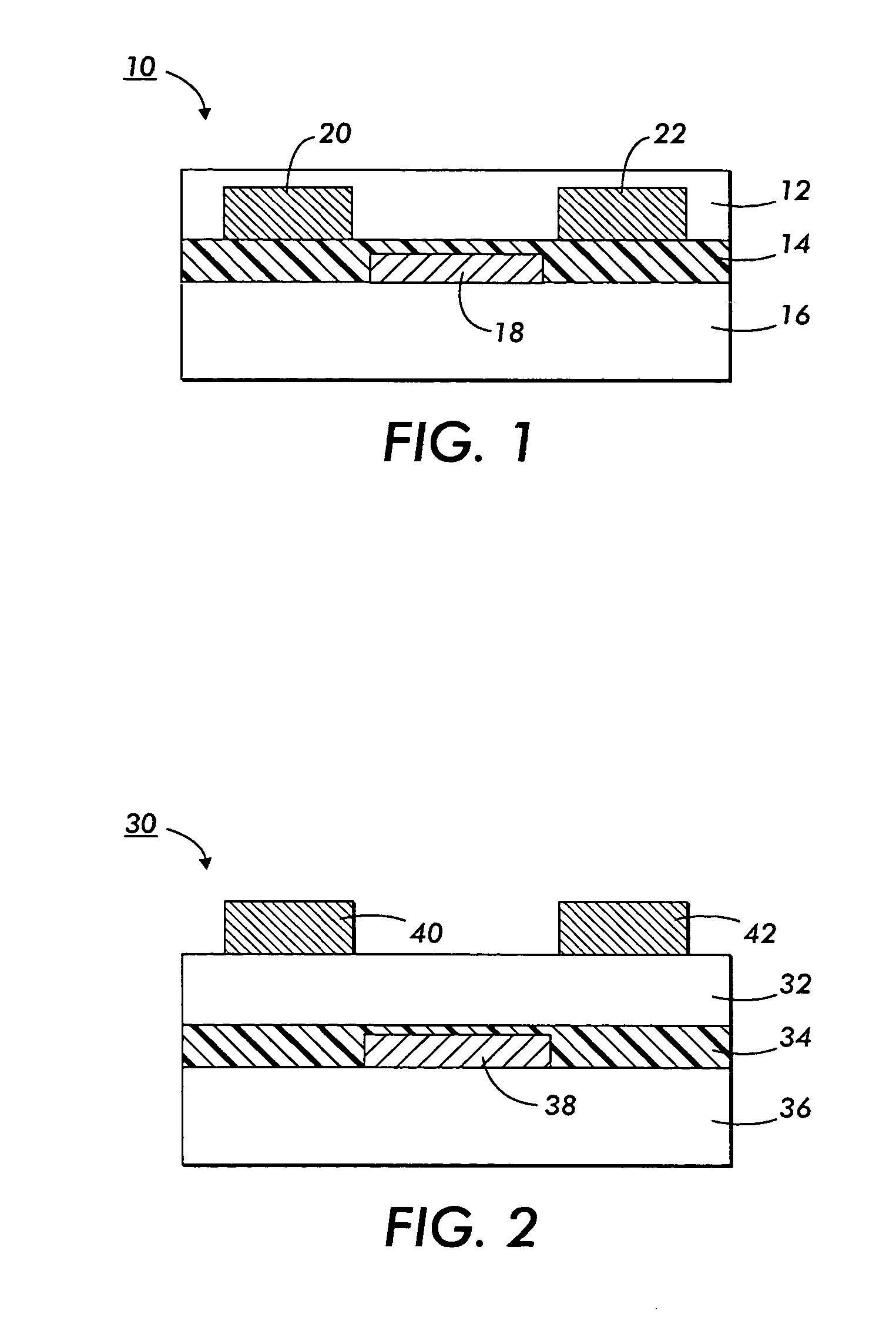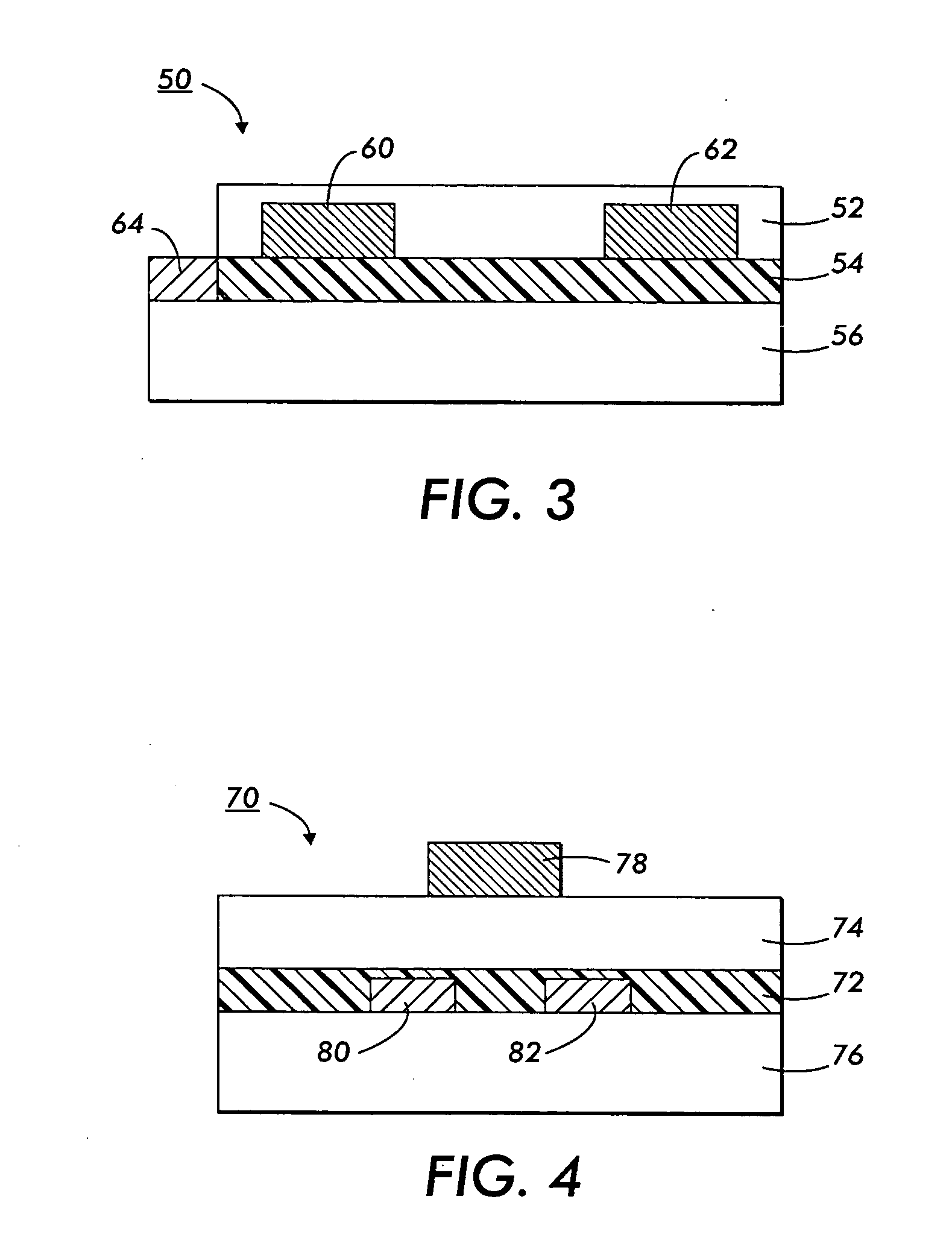Polythiophenes and electronic devices generated therefrom
a technology of polythiophene and electronic devices, applied in the field of polythiophene, can solve the problems of large off-current, low current on/off ratio of the devices fabricated from these materials, and add to the cost of manufacturing
- Summary
- Abstract
- Description
- Claims
- Application Information
AI Technical Summary
Benefits of technology
Problems solved by technology
Method used
Image
Examples
example 1
Synthesis of Poly[5,5′-bis(3-dodecyl-2-thienyl)-2,2′-dithiophene] (II-e)
The monomer 5,5′-bis(3-dodecyl-2-thienyl)-2,2′-dithiophene for the preparation of (IIe) was synthesized as follows:
A solution of 2-bromo-3-dodecylthiophene (11.5 grams, 34.92 mmol) in 40 milliliters of anhydrous tetrahydrofuran (THF) was added slowly over a period of 20 minutes to a mechanically stirred suspension of magnesium turnings (1.26 grams, 51.83 mmol) in 10 milliliters of THF (tetrahydrofuran) in a 100 milliliter round-bottomed flask under an inert argon atmosphere. The resultant mixture was stirred at room temperature of about 22° C. to 25° C. for 2 hours, and then at 50° C. for 20 minutes before cooling down to room temperature. The resultant mixture was then added via a cannula to a mixture of 5,5′-dibromo-2,2′-dithiophene (4.5 grams, 13.88 mmol) and [1,3-bis(diphenylphosphino]dichloronickel (II) (0.189 gram, 0.35 mmol) in 80 milliliters of anhydrous THF in a 250 milliliter round-bottomed flask ...
example 2
Alternative Preparation of Polythiophene (II-e)
A solution of 5,5′-bis(3-dodecyl-2-thienyl)-2,2′-dithiophene (2.0 grams, 3.0 mmol) in 60 milliliters of chlorobenzene was added to a well-stirred mixture of FeCl3 (2.0 grams, 14.79 mmol) in 20 milliliters of chlorobenzene in a 250 milliliter round-bottomed flask under an argon atmosphere over a period of 5 minutes. The resultant mixture was heated at 65° C. for 48 hours under argon. After the polymerization, the mixture was diluted with 200 milliliters of methylene chloride and washed three times with water. The organic phase was separated and stirred with 400 milliliters of 7.5 percent aqueous ammonia solution for 1 hour. The organic layer was separated, and washed three times with water. The crude polymer was precipitated from 600 milliliters of methanol, and then purified by Soxhlet extraction with methanol and heptane. The purified polymer was then extracted out with 400 milliliters hot chlorobenzene and then precipitated from 15...
example 3
Preparation of Polythiophene (II-r)
The monomer of polythiophene (II-r) was prepared in accordance with the monomer preparation procedure of Example 1 except that 2-bromo-3-hexadecylthiophene was employed instead of 2-bromo-3-dodecylthiophene. The crude monomer was purified by column chromatography on silica gel and recrystallized from a mixture of methanol and isopropanol, affording pure 5,5′-bis(3-hexadecyl-2-thienyl)-2,2′-dithiophene as a yellow crystalline product in 64 percent yield, m.p. 72.3° C.
1H NMR (CDCl3, ppm): δ 7.19 (d, 2H), 7.14 (d, 2H), 7.02 (d, 2H), 6.93 (d, 2H), 2.78 (t, 4H), 1.66 (q, 4H), 1.29 (bs, 36H), 0.88 (m, 6H).
The polymerization was conducted in the same manner as in Example 2 except that 5,5′-bis(3-hexadecyl-2-thienyl)-2,2′-dithiophene was utilized instead of 5,5′-bis(3-dodecyl-2-thienyl)-2,2′-dithiophene. Polythiophene (II-r) was obtained in 70 percent yield with the following molecular weight properties: Mw, 69,000; Mn, 26,000 relative to polystyrene...
PUM
| Property | Measurement | Unit |
|---|---|---|
| band gap | aaaaa | aaaaa |
| semiconductive | aaaaa | aaaaa |
| degree of polymerization | aaaaa | aaaaa |
Abstract
Description
Claims
Application Information
 Login to View More
Login to View More - R&D
- Intellectual Property
- Life Sciences
- Materials
- Tech Scout
- Unparalleled Data Quality
- Higher Quality Content
- 60% Fewer Hallucinations
Browse by: Latest US Patents, China's latest patents, Technical Efficacy Thesaurus, Application Domain, Technology Topic, Popular Technical Reports.
© 2025 PatSnap. All rights reserved.Legal|Privacy policy|Modern Slavery Act Transparency Statement|Sitemap|About US| Contact US: help@patsnap.com



